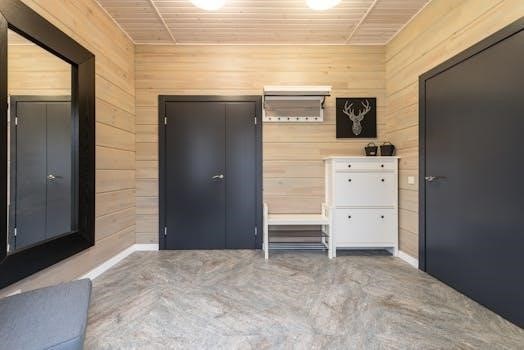Overview of Sliding Closet Door Floor Guides
Sliding closet door floor guides are crucial for maintaining door alignment and smooth operation. These guides, often made of nylon, typically work with a top track system. They ensure the bottom of the door stays on course, preventing rubbing and sticking. Carpeted floors present unique challenges, requiring special considerations for guide installation.
Types of Sliding Closet Doors and Guides
Sliding closet doors commonly come in bypass styles, where two or more doors slide past each other on a top-mounted track. These doors utilize floor guides to keep them aligned at the bottom. The guides themselves vary; some are simple plastic or nylon pieces, while others offer adjustability for different door thicknesses. Many guides are designed to work with carpet risers, small plastic wedges that elevate the guide above the carpet pile. Some guides are specifically designed for easy installation, offering features like nail-on options. These guides are usually made of durable materials designed to withstand constant use. Understanding these differences is key to selecting the proper guide for your specific door and flooring situation. The materials of the guides can range from nylon to plastic, and they might come with or without carpet risers included.

Preparing for Installation on Carpet
Installing floor guides on carpet requires careful preparation. Assessing carpet thickness and pile is crucial. Gathering the necessary tools and materials is also a key step before starting the installation process.
Assessing Carpet Thickness and Pile
Before installing a sliding closet door floor guide on carpet, it is essential to accurately assess the carpet’s thickness and pile. A thick carpet pile can significantly affect the guide’s positioning and functionality, potentially causing the door to bind or not slide smoothly. The carpet’s thickness will determine the need for carpet risers or shims to elevate the guide to the correct height. A high pile carpet will require taller risers than a low pile. The goal is to ensure the bottom of the door is properly aligned and does not rub against the carpet. The pile density will influence how much the carpet will compress under pressure, affecting the final guide placement. Carefully consider these factors to achieve a successful and long-lasting installation. This assessment is crucial for selecting the appropriate hardware and ensuring smooth door operation.
Required Tools and Materials
To properly install a sliding closet door floor guide on carpet, you’ll need a specific set of tools and materials. First, a Phillips head screwdriver is essential for securing the guide and risers. You may also need a drill with appropriately sized drill bits for creating pilot holes, especially when working with concrete subfloors. A measuring tape will ensure accurate positioning of the guide. Carpet risers or shims are crucial to elevate the guide above the carpet pile. Consider purchasing a kit that includes these risers for adjustable height. Long screws, typically 1 1/4 to 1 1/2 inches, are needed to secure the guide through the carpet and into the subfloor. Additionally, a utility knife or sharp blade might be necessary for making small slits in the carpet for the guide. Lastly, consider using headless finish nails to mark the screw positions, ensuring accurate installation.

Installation Process
Installing a floor guide on carpet involves careful marking, using risers or shims to compensate for the carpet pile, and securely fastening the guide to the floor. This ensures proper door alignment.
Marking the Floor Guide Position
Accurately marking the floor for the guide is a critical first step when installing a sliding closet door floor guide on carpet. Begin by positioning the sliding doors in their tracks to determine the ideal location for the guide. Use headless finish nails to mark the screw hole positions by gently tapping them into the carpet where the guide will be placed, leaving them slightly protruding. Carefully slit the carpet where the vertical part of the guide will come up through the carpet. This ensures the guide will align correctly with the doors and will move freely without interference. Proper marking is vital for a smooth installation and to achieve the optimal functionality of your sliding doors. This will help you to avoid any misalignment and ensure that the doors will move without obstruction.
Using Carpet Risers or Shims
When installing sliding closet door floor guides on carpet, carpet risers or shims are essential to ensure proper functionality. These risers elevate the guide above the carpet pile, preventing it from being buried or interfering with the door’s movement. Typically made of thin plastic wedges, they are placed under the guide, matching its screw holes, providing a stable base. Risers are available in varying thicknesses, allowing for precise height adjustments, usually in increments of 1/8 inch. This is crucial for accommodating different carpet thicknesses and piles, ensuring the guide doesn’t bind or cause the doors to stick. Using carpet risers is particularly important when working with thicker carpets to maintain the necessary clearance for smooth sliding door operation. Long screws, such as 1 1/4 to 1 1/2 inches are used to secure the guide and riser to the floor.
Securing the Floor Guide
Securing the floor guide properly is crucial for the smooth operation of sliding closet doors, especially when dealing with carpeted surfaces. After positioning the guide and any necessary risers, use appropriate screws to fasten it to the subfloor. It’s important to use screws that are long enough to penetrate the carpet and securely grip the floor beneath, typically 1 1/4 to 1 1/2 inches in length. For concrete floors, pre-drilling pilot holes may be necessary. Ensure the guide is firmly attached, but avoid over-tightening the screws which can damage the guide or underlying floor. The guide should be positioned so that the door glides smoothly within it, without any binding or wobbling. Double-check the alignment and stability before completing the installation to avoid future issues. The goal is a solid, reliable attachment that keeps the doors on track.

Troubleshooting and Adjustments
After installation, issues like uneven carpet or binding may arise. Adjusting guide height or using shims can correct these problems. Ensuring proper door alignment is key for smooth, trouble-free operation.
Dealing with Uneven Carpet
Uneven carpet presents a significant challenge when installing sliding closet door floor guides. The variability in carpet pile and thickness can cause the door guide to sit at an angle, leading to binding or improper door alignment. To address this, careful assessment of the carpet’s surface is crucial. You might find that one area is more compressed than another, affecting how the guide rests. Utilizing shims or carpet risers becomes essential to level the guide, ensuring that it sits flush and provides the necessary support for the sliding door. These risers, often thin plastic wedges, can be used to build up low spots, creating a consistent base for the floor guide. It is important to use a level to check that the guide is perfectly level relative to the floor, and not resting on the carpet. This will contribute to the smooth operation of the doors and prevent premature wear and tear.
Adjusting Guide Height
Adjusting the height of the floor guide is a critical step in ensuring smooth sliding door operation, especially on carpeted surfaces. The guide needs to be positioned so that it adequately controls the door’s movement without causing friction or binding. Many guides offer built-in adjustability, allowing for fine-tuning of their height using screws or other mechanisms. Carpet risers, often included with the guide, are also instrumental in achieving the correct height. These risers, typically thin plastic wedges, can be stacked to raise the guide incrementally above the carpet pile. It’s important to adjust the guide height so that the door glides smoothly without rubbing against the guide or the floor. If the guide is too low, the door might drag, and if it’s too high, it might not be properly supported. Trial and error, combined with careful observation, is essential when adjusting guide height.

Alternative Solutions
When standard methods fail, consider cutting back carpet around the guide area. Different guide types, like nail-on guides, offer another approach. Curtains or other creative options can be suitable alternatives to traditional doors.
Cutting Back Carpet
If carpet thickness or pile is causing significant issues with your sliding closet door floor guide, carefully cutting back the carpet around the guide’s placement area can be a viable solution. This involves precisely removing a section of carpet, ensuring the guide sits directly on the subfloor or a thin riser. This technique creates a level surface for the guide, preventing it from rocking or shifting. Use a sharp utility knife to make clean cuts, following the guide’s perimeter, and removing just enough carpet to allow for proper function. Be cautious not to remove too much, as this may create a gap. This approach can be particularly useful when dealing with very thick or plush carpets that are unsuitable for standard risers. The goal is to achieve a stable base for the guide, ensuring the door slides smoothly without any obstruction or binding against the carpet fibers. Always double-check the guide’s alignment and operation after this modification to ensure success and safe usage.
Using Different Guide Types
When faced with challenging carpet conditions, exploring different types of floor guides can be beneficial. Standard guides might not always be suitable, prompting the consideration of alternatives designed for varied floor surfaces. Some guides feature adjustable heights or wider bases that provide better stability on carpet. Consider guides that are designed to be mounted on risers or have a low profile to minimize carpet interference. There are also specialized guides that use a different approach, such as a center guide bracket that keeps the bottom of the doors aligned. These variations can help overcome the problems associated with soft surfaces, and prevent the door from binding or rubbing against the carpet. Choosing a guide with a different design may also be preferable for those with a specific door type or aesthetic preference. Carefully assess your door and floor conditions before making a final choice to ensure the selected guide is compatible and functional. This adaptability can be crucial for optimal operation.
